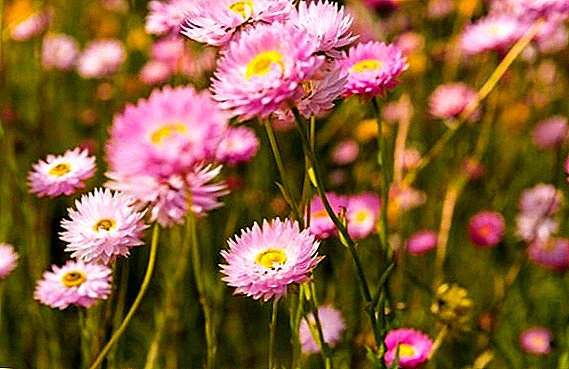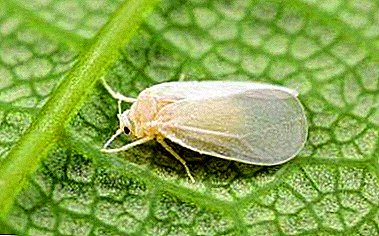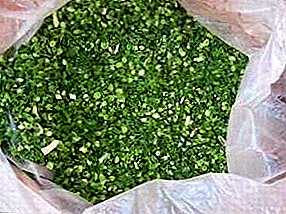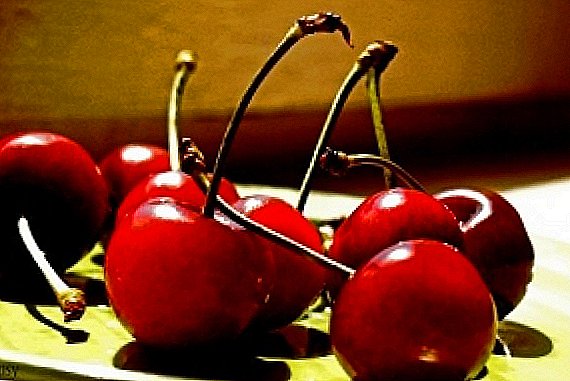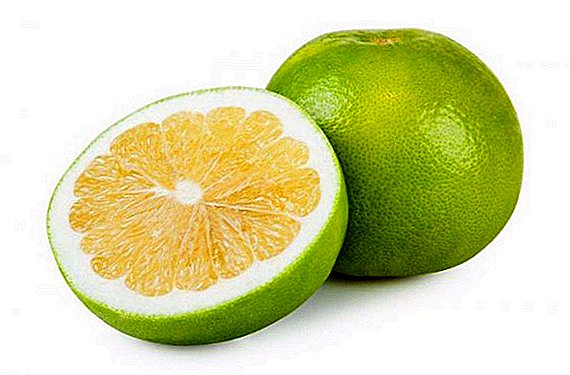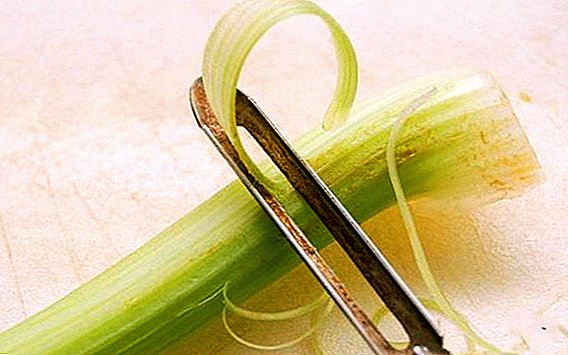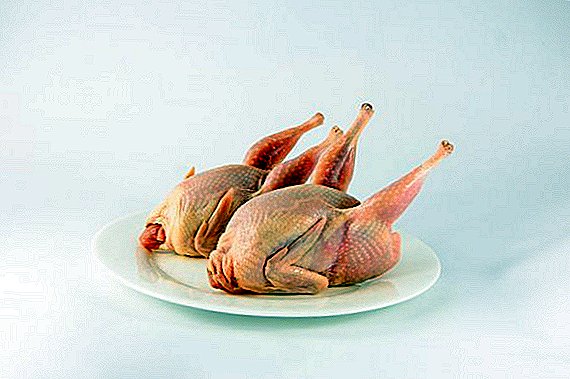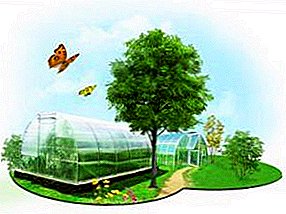
New coating material all types of greenhouses and greenhouses confidently pressed traditional glass and film. Most consumers no longer have a question: what is the best polycarbonate or film for the greenhouse? Rather, what kind of polycarbonate is needed for a greenhouse?
Manufacturers have taken care of a variety of types of this plastic, which differ significantly in many ways.
Our task is choose the best option, so that the price does not hit the budget too much, and the building served without repair as long as possible.
Short story
Polycarbonate - plastic based on polymer raw materials. Interestingly, the substance itself was obtained in 1953, almost simultaneously in the German company "BAYER" and the American "General Electric".
The industrial production of raw materials dates back to the late sixties of the twentieth century. But the sheet polycarbonate sheet was first made in Israel, two decades later.
The material had unique qualities:
- Transparency;
- Strength;
- Flexibility;
- High thermal insulation characteristics;
- Ease;
- Easy installation;
- Resistance to temperature changes;
- Security;
- Chemical resistance;
- Environmental friendliness.
A remarkable combination of the technical characteristics of this polymer material was the reason for its popularity. The scope of its application is extensive, and in the private sector it has become a favorite material for covering greenhouses.
Types of plastic for greenhouses
Before answering the main question: how to choose polycarbonate greenhouses made of polycarbonate, let's look at the types of this modern material on the market.
The structure is distinguished monolithic and cellular (cellular) polycarbonate. Monolithic, as the name implies, are solid sheets of various thickness and sizes. With the help of hot forming, they are able to take any form, which is very convenient during the construction of complex structures.
Monolithic strength of materials abovethan the cellular. They can be used for floors without additional frames. Available in various colors, as well as in the form of transparent colorless sheets. Monolithic plastic for greenhouses can be used, but it is quite expensive.
The air gap filling the space of cells increases the heat-shielding properties, which is of great importance for greenhouse greenhouse structures.
 Separately need to say about polycarbonate lightweight brands. It is made with thinner external and internal partitions, which allows to save raw materials and reduce its cost, but the operational characteristics do not benefit from this.
Separately need to say about polycarbonate lightweight brands. It is made with thinner external and internal partitions, which allows to save raw materials and reduce its cost, but the operational characteristics do not benefit from this.
The only plus is affordable price. Used for temporary greenhouses, as a worthy replacement for film coating.
The market presents products of domestic and imported manufacturers.
Of Russian trademarks recognized leaders are "ROYALPLAST", "Sellex" and "Karat", producing high-grade quality material. Such companies as Polynex and Novattro have proven themselves well.
The brands of polycarbonate Ecoplast and Kinplast specialize in producing cheaper, lighter modifications. A distinctive feature of carbonates of Russian manufacturers is that they are better adapted to our weather conditions.
The main competitor of our manufacturers is China, whose products do not differ in quality, but are affordable.
Cellular polycarbonate for greenhouses
What polycarbonate is used in our country most often? Why do many gardeners prefer cellular polycarbonatebuilding shelters for your plants? Let's name the main reasons:
- Cost is much lower than monolithic sheets.
- Thermal insulation is the best.
- Low weight with high strength.
- The upper plane of the sheet always has a special coating to protect against UV light.
Of the shortcomings should be noted weak abrasive resistance impact and cyclic expansion - compressing the material when changing temperatures.
The choice of a cellular polymer from the variety of its types is a crucial moment on which the functionality and service life of the finished structure and construction cost will depend.
With a free budget, you should not save, it is better to buy plastic from leading manufacturers of premium brands. But how much thickness is needed for greenhouse polycarbonate? The answer is simple:
Therefore, it is necessary to take into account all factors - size of the building, purpose (spring or winter version), the number of consumables and possible loads on the roof and walls. All this will help to avoid unnecessary costs.
Standard sheet dimensions (2.1 x 6 or 2.1 x 12 meters) are the same for any thickness. Consumption of the necessary material should be considered, given the rationality of cutting.
Important: Stiffeners always vertical! Do not forget about this when cutting!
A budget option greenhouses using thin sheets of polycarbonate will be valid as such only with a small building size.
With larger dimensions, to increase the parameters of possible load-bearing loads, the frame will require a smaller pitch of the batten.
As a result - an increase in the cost of consumables, and such a greenhouse will last for a very short time.
 The everyday reality is that a fairly large segment of the population has very modest incomes. That is why many consciously choose the cheapest material for the greenhouse, in the hope that in the near future financial matters will get better, and it will be possible to replace the greenhouse with a better one.
The everyday reality is that a fairly large segment of the population has very modest incomes. That is why many consciously choose the cheapest material for the greenhouse, in the hope that in the near future financial matters will get better, and it will be possible to replace the greenhouse with a better one.
Such an approach has a right to exist, especially in the case when the calculation is used to grow vegetables, herbs, flowers or berries for sale. After all, if things go well, then part of the income can be spent on building a more solid option.
In the event that you want to build reliable greenhouse for their own needs, it is necessary to carve out a fairly large amount from the budget - the absence of the need for annual repairs is more than worth the investment.
Sheet thickness standards
The thickness of polycarbonate offered by manufacturers is 16, 10, 8, 6, 4 mm and lightweight series with a thickness of 3 to 3.5 mm. By special order produce sheets of 20 and 32 mm, which is for very strong structures. For the manufacture of greenhouses most often used sheets with a thickness of 4-8 mm.
The 10 mm sheet is well suited for glazing vertical walls of sports facilities, swimming pools, etc. Sheet 16 mm thick suitable for roofing large areas.
Polycarbonate is widely used in the advertising industry - billboards, light boxes and other structures made of it are easy to install, have a good appearance and last a long time.
For greenhouses sheet thickness choose depending on the destination. The minimum allowable at which she can serve at least several years is 4 mm. The climate in Russia is not at all mild, so it is preferable to use thicker sheets.
Bend radius sheet directly depends on its thickness. In the table below: polycarbonate sheets for greenhouse sizes. When developing a preliminary project, these data will help to correctly calculate the required amount of material and choose the best option. In addition, the actual density of polycarbonate should be clarified with the seller or supplier.
| Sheet thickness, mm | Sheet width, mm | The distance between the ribs, mm | Minimum bending radius, mm | U factor |
| 4 | 2100 | 5,7 | 700 | 3,9 |
| 6 | 2100 | 5,7 | 1050 | 3,7 |
| 8 | 2100 | 11 | 1400 | 3,4 |
| 10 | 2100 | 11 | 1750 | 3,1 |
| 16 | 2100 | 20 | 2800 | 2,4 |
Polycarbonate Cell Life
Companies specializing in the production of polycarbonate premium brands, declare the life of their product to 20 years. These are mainly products of European brands. Of the Russian in this segment, it is worth noting the ROYALPLAST brand.
Average polycarbonate lifeproduced in Russia is 10 years. The Chinese equivalent, which is quite a lot in our market, is often made from recycled materials, which adversely affects the quality. 5-7 years of service of such a polycarbonate will be the limit.
A photo
In the photo: monolithic polycarbonate greenhouse, polycarbonate greenhouse sheets - properties






Practical advice on the choice of material and installation
Whatever polycarbonate option you choose, you should always pay attention to quality. The more well-known the manufacturer, the more it values its reputation, and therefore produces higher-quality goods. Quality products have:
- Marker manufacturer. Usually it is located on the front side, and contains information about the thickness, sheet size, manufacturer, material brand and release date. The UV protection layer is always located on the front side and must be outside when installed. On lightweight stamps put the designation "Light", or do not indicate the thickness of the sheet. (3-4mm).
- Nice appearance. The surface is smooth and even, without scratches and kinks. Sheets on both sides are covered with a thin film, on the front side there is a company logo on the film. The material should not contain turbid opaque areas, bubbles and other inclusions.
An important indicator is packing condition. It should be clean, free from damage. In the warehouse, the sheets lie in a horizontal position and their surface should not have any bends and waves - if there is one, then the material is of poor quality.
Even an experienced craftsman doesn’t always succeed in clearly distinguishing quality polycarbonate from cheap fakes. Read the product documentation before purchasing.
Sometimes unscrupulous "left" firms, hoping for ignorance or excessive gullibility of customers, put on sale a poor-quality product and point on the packaging logos of even such brands that are not supplied to Russia.
Largely build quality will depend on the correct installation and selection of consumables for the batten. The holes for fasteners should be slightly larger than the diameter of the screw or bolt in order to prevent cracking of panels from thermal expansion and contraction. Under the cap fasteners must put a rubber washer.
Panels themselves mounted on a special H-shaped profile. All open edges of the material are closed with special vapor-permeable profile - this will prevent the ingress of moisture and foreign particles into the sheet. The bottom edge of the sheet should be left open, and condensate will flow through it.
At observance of all rules of installation and a successful choice the covering for the greenhouse will serve long and reliably. We hope that our information turned out to be useful to you and now you know for sure which polycarbonate is better for greenhouses.


